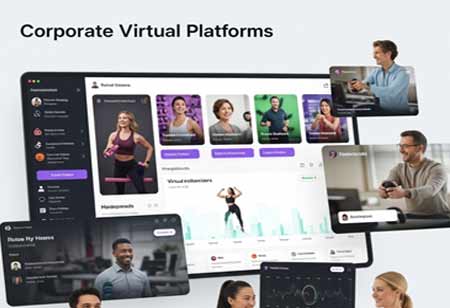THANK YOU FOR SUBSCRIBING
Be first to read the latest tech news, Industry Leader's Insights, and CIO interviews of medium and large enterprises exclusively from Hrtech Outlook
THANK YOU FOR SUBSCRIBING

By
HR Tech Outlook | Friday, August 08, 2025
Stay ahead of the industry with exclusive feature stories on the top companies, expert insights and the latest news delivered straight to your inbox. Subscribe today.
Employee wellness has emerged as a critical component of contemporary corporate culture. Wellness initiatives have progressed beyond singular gym reimbursements or annual health fairs; they are now evolving into integrated and technologically advanced experiences. Corporate virtual fitness platforms represent one of the most innovative developments among these advancements. These platforms facilitate physical activity and redefine organizational perspectives on productivity, employee engagement, and long-term job satisfaction.
Consequently, the scope of workplace wellness has expanded, incorporating fitness into the corporate digital ecosystem. This transition underscores a growing recognition that health is fundamentally linked to employee performance. Organizations are elevating their standards for work-life balance, reevaluating the perception of employee health from a mere benefit to an essential strategy for corporate success.
Virtual fitness platforms are designed to be customizable and adaptable, effectively catering to employees' diverse needs. More significantly, they promote a culture of wellness that transcends traditional office boundaries.
A new approach to employee engagement and performance
The most powerful idea underlying a corporate virtual fitness platform is that people who feel well do better work. All fitness offerings include live-stream classes, on-demand workouts, meditation sessions, and tailored training. Such extensive offerings cater to employees of different fitness levels and preferences. High-intensity workouts before a relevant presentation or calming yoga after a hectic day of meetings all tend to have flexibility present through these platforms, allowing individuals to engage and interact with fitness according to their preferences.
Most importantly, these resources create ability, and there is less inclusion of feelings concerning it. Employees do not have to take time to go to a gym or feel embarrassed about working out with others; they can decide when and how they want to work out, thus increasing the likelihood of sticking with it. Companies are tearing down many of the barriers previously associated with fitness, therefore nurturing a proactive health mindset that may translate into high focus, creativity, and emotional resilience.
Such advantages are not purely personal but organizational. Investment in virtual fitness reduces absenteeism costs, maintains health, and increases job satisfaction in the workplace. Employees who feel cared for are likelier to stay, contribute fully, and advocate for the company’s values. In this way, fitness becomes more than a personal goal—it becomes a shared asset.
Scalability, Customization, and Data-Driven Insights
Virtual fitness platforms present a compelling proposition for organizations, as they can be tailored to meet the specific needs of diverse workforces, whether composed of fifty employees or fifty thousand. These platforms can be adjusted in size and structure to align with various organizational requirements, facilitating the deployment of programs across different departments, time zones, and geographical locations. Consequently, employees receive consistent wellness support, regardless of their physical location. This inclusivity is particularly significant in hybrid and remote work environments, where in-person participation is increasingly uncommon.
Moreover, customization represents a notable strength of these platforms. They can be designed around organizational goals, company traditions, and seasonal challenges. Integration with wellness initiatives can also foster friendly competition or encourage stress-management activities during peak periods, such as before a product launch or at the end of a fiscal year. In this manner, these platforms enable organizations to remain agile and responsive while prioritizing the well-being of their employees.
Many of these virtual fitness platforms additionally provide comprehensive analytics and reporting capabilities. By tracking participation rates, time allocated to activities, and feedback scores, organizations can assess the effectiveness of their wellness initiatives. This data empowers human resources departments to make informed and timely program adjustments, ensuring their continuous relevance and efficacy. Advanced platforms offer aggregated wellness trends, equipping organizations with strategic insights that inform broader organizational culture, employee retention, and workforce development decisions.
Fostering a Culture of Health Beyond the Digital Realm
The true value of a virtual fitness platform lies in the culture it cultivates; technology serves merely as the facilitator. This shift transforms fitness from an individual endeavor into a collective experience shared across teams, with numerous online and offline events as milestones in virtual challenges. Such supportive communities help employees feel connected, fostering collaboration across various departments, even when physically distant.
Leadership recognizes that these virtual fitness platforms can be pivotal in embedding wellness into the organizational routine. It is essential for executives and managers to actively engage in wellness behaviors actively, thereby modeling healthy practices for employees and underscoring the priority placed on health within the organization.
Organizations can establish wellness as a lasting aspect of their corporate identity by normalizing wellness within the corporate culture, acknowledging employee contributions, celebrating wellness achievements, and consistently encouraging healthy habits. Ultimately, these platforms offer contemporary tools for enhancing employee health and play a crucial role in transforming organizational culture by emphasizing technology, empathy, health, and professional development.



